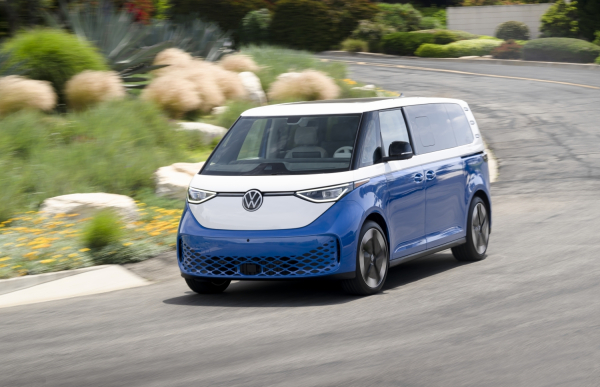Volkswagen of America introduced the three-row ID. Buzz in Huntington Beach, California. Tribute to the iconic Volkswagen Microbus, the three-row ID. Buzz has been designed specifically for North America. It offers a longer wheelbase than the European two-row vehicle that debuted in 2022 (previous post), plus a bigger battery and more horsepower. The identifier of three rows. Buzz is planned for sale in the US market starting in 2024.
As with the original Bus, the three-row identifier. Buzz has a rear-mounted engine as standard. The rear engine produces 282 horsepower, compared to the European-spec two-row model, which debuted with 201 hp. The battery is also larger at 91 kWh (gross), compared to the 82 kWh battery in the two-row model.
The efficient design of the skateboard, with the battery mounted on the floor, not only saves space, but also contributes to better handling by placing a large percentage of the weight of the vehicle below the structure. The all-wheel-drive GTX version is available for the three-row ID. Buzz at launch, with around 330 hp and two engines. Like all current Modular Electric Drive (MEB) vehicles, the Buzz uses a multi-link rear suspension and struts at the front.
The new rear-mounted APP550 motor is a PMS (permanent magnet synchronous) design with a maximum torque of 406 lb-ft (550 N·m), equipped with a single-speed transmission and a new inverter (electronic of power and control). The increase in power, torque and efficiency is achieved by a rotor with stronger permanent magnets that have a high thermal load capacity, a newly developed stator with a larger effective number of turns and a maximum wire section, a outdoor water cooling jacket. of the stator, and a combined oil and water cooling system that also guarantees greater thermal stability.
The new ID electric motor. Buzz raises the top speed to an electronically limited 99 mph, up from 90 mph in both rows.
Outside, the ID. Buzz retains its traditionally boxy shape with short overhangs, giving it maximum utility with a minimal footprint. It’s 192.4 inches long, nearly 10 inches longer than the two-row Buzz; all that extra length comes from a 127.5-inch wheelbase, compared to 117.6 inches for the two rows. It’s 77.9 inches wide and 74.6 inches tall, making it about as wide as an Atlas, but five inches taller. Given that the original bus was about as long as a 2019 Beetle and a bit narrower, that’s a considerable increase. The drag coefficient is only 0.29, very good for a vehicle of this shape.
Double sliding rear doors with easy opening and closing provide access to the third row and are filled with a modern version of the classic sliding windows, also fully powered. The Buzz also features standard power folding and heated side mirrors, plus a standard power tailgate with Easy Open and Close. These features allow owners to approach the vehicle with the keys in their pocket or purse and kick under the rear bumper to open or close the tailgate as needed. Proximity unlocking and keyless entry with illuminated front door handles make entry easy. On the D-pillar, the air “vents” recall the rear engine cooling slots of the original Bus. The aerodynamically optimized 20-inch wheels are four inches larger in diameter than those on a 1950 T2 model.
IQ.DRIVE driver assistance technology, which includes Level 2 practical capability, is standard on the ID. Buzz. On the highway, IQ.DRIVE includes lane centering and a capacitive steering wheel to make driving easier. In the city, IQ.DRIVE helps you to alert you of obstacles in front of you and monitors your surroundings to help you drive safer. The Dynamic Traffic Sign Display is also standard, and there are forward view functions, Park Assist with remote parking and Area View.


